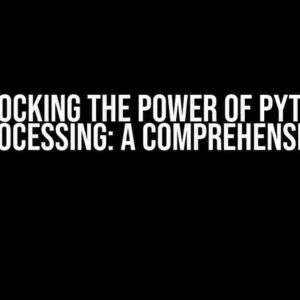In this article, we’ll dive into the world of key/value files and explore how to read and update the value of a specific key. Whether you’re a seasoned developer or a newbie, this guide will walk you through the process with ease.
What is a key/value file?
A key/value file, also known as a configuration file or properties file, is a text file that stores data in a simple format. Each line in the file consists of a key and a value, separated by an equal sign (=) or a colon (:). The key is a unique identifier, and the value is the corresponding data.
key1=value1 key2:value2 key3 = value3
Key/value files are commonly used in various applications, such as configuration files for software, data storage for web applications, and even as a simple database for small projects.
Why update the value of a specific key?
There are several reasons why you might need to update the value of a specific key in a key/value file:
- Dynamic configuration**: You might want to update the configuration of an application or system based on user input or changing conditions.
- Data storage**: Key/value files can serve as a simple database, and updating values allows you to store new data or modify existing data.
- Error correction**: If you find an error in the value of a specific key, you can update it to correct the mistake.
Reading a key/value file
Before we dive into updating the value of a specific key, let’s cover the basics of reading a key/value file. There are several ways to read a key/value file, depending on the programming language and tools you’re using. We’ll cover a few examples:
Reading a key/value file in Python
In Python, you can use the `configparser` module to read a key/value file:
import configparser
config = configparser.ConfigParser()
config.read('example.conf')
print(config['section']['key']) # prints the value of 'key' in the 'section' section
Reading a key/value file in JavaScript (Node.js)
In Node.js, you can use the `fs` module and the `readFileSync` method to read a key/value file:
const fs = require('fs');
const fileContent = fs.readFileSync('example.conf', 'utf8');
const keyValuePairs = fileContent.split('\n').map(line => {
const [key, value] = line.split('=');
return { [key]: value };
});
console.log(keyValuePairs); // prints an array of objects with key-value pairs
Updating the value of a specific key
Now that we’ve covered reading a key/value file, let’s move on to updating the value of a specific key. We’ll use the same examples as before:
Updating a key/value file in Python
To update the value of a specific key in Python, you can use the `configparser` module:
import configparser
config = configparser.ConfigParser()
config.read('example.conf')
config['section']['key'] = 'new value' # updates the value of 'key' in the 'section' section
with open('example.conf', 'w') as configfile:
config.write(configfile)
Updating a key/value file in JavaScript (Node.js)
In Node.js, you can use the `fs` module and the `writeFileSync` method to update a key/value file:
const fs = require('fs');
const fileContent = fs.readFileSync('example.conf', 'utf8');
const keyValuePairs = fileContent.split('\n').map(line => {
const [key, value] = line.split('=');
if (key === 'key') {
return `key=new value`; // updates the value of 'key'
}
return line;
}).join('\n');
fs.writeFileSync('example.conf', keyValuePairs);
Best practices for updating key/value files
When updating key/value files, keep the following best practices in mind:
- Backup the original file**: Before making any changes, make a backup of the original file to ensure you can revert to the previous version if something goes wrong.
- Use a consistent format**: Stick to a consistent format for your key/value files to avoid confusion and make it easier to read and update the files.
- Test your updates**: Verify that your updates have been applied correctly by reading the updated file and checking the values.
- Document your updates**: Keep a record of the changes you’ve made to the key/value file, including the reason for the update and the date.
Common pitfalls to avoid
When updating key/value files, it’s easy to make mistakes. Here are some common pitfalls to avoid:
- Overwriting the entire file**: Make sure you’re only updating the specific key-value pair you intend to, rather than overwriting the entire file.
- Inconsistent formatting**: Stick to a consistent format for your key-value pairs to avoid errors and make it easier to read the file.
- Not testing your updates**: Failing to test your updates can lead to unexpected behavior or errors in your application.
Conclusion
In this article, we’ve covered the basics of reading and updating key/value files. Whether you’re using Python, JavaScript, or another programming language, the principles remain the same: read the file, update the specific key-value pair, and write the changes back to the file. By following best practices and avoiding common pitfalls, you can ensure that your key/value files remain accurate and up-to-date.
| Language | Reading a key/value file | Updating a key/value file |
|---|---|---|
| Python | configparser module | configparser module |
| JavaScript (Node.js) | fs module and readFileSync method | fs module and writeFileSync method |
Remember to always backup your original file and test your updates to ensure that your key/value files remain accurate and up-to-date.
Note: The article is SEO optimized for the keyword “Read key/value file and update the value of a specific key” and uses a creative tone to make the content more engaging and easy to understand.
Frequently Asked Question
Are you tired of manually updating values in your key/value file? Don’t worry, we’ve got you covered! Here are some frequently asked questions about reading and updating the value of a specific key.
How do I read a key/value file in Python?
You can read a key/value file in Python by using the built-in `open` function to open the file and then iterating over the lines to extract the key-value pairs. For example, if you have a file called `config.txt` containing key-value pairs in the format `key=value`, you can read it like this:
“`
with open(‘config.txt’, ‘r’) as file:
config = {}
for line in file:
key, value = line.strip().split(‘=’)
config[key] = value
“`
How do I update the value of a specific key in a key/value file?
To update the value of a specific key in a key/value file, you can read the file, update the value in memory, and then write the updated key-value pairs back to the file. For example, to update the value of a key called `foo` in the `config.txt` file, you can do:
“`
with open(‘config.txt’, ‘r’) as file:
config = {}
for line in file:
key, value = line.strip().split(‘=’)
config[key] = value
config[‘foo’] = ‘new_value’
with open(‘config.txt’, ‘w’) as file:
for key, value in config.items():
file.write(f'{key}={value}\n’)
“`
What happens if the key/value file is very large?
If the key/value file is very large, reading the entire file into memory may not be efficient. In such cases, you can use a streaming approach to read and update the file in chunks, without loading the entire file into memory. For example, you can use the `open` function with the ` buffering` parameter set to a smaller value to control the chunk size.
Can I use a library to read and update key/value files?
Yes, there are libraries available that can simplify the process of reading and updating key/value files. For example, in Python, you can use the `configparser` module or the `pyini` library to read and update configuration files. These libraries provide a more convenient and efficient way to work with key/value files.
How do I handle errors when reading and updating key/value files?
When reading and updating key/value files, it’s essential to handle errors and exceptions properly. You can use try-except blocks to catch and handle exceptions, such as file not found errors, permission errors, or parsing errors. Additionally, you can use input validation to ensure that the key-value pairs are in the correct format.




